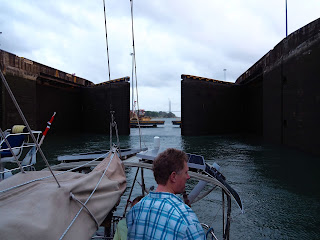Transiting the Panama Canal
The isthmus where the continents of North and South America
join has been well travelled for the past 500 years. During the 1500’s, the
Spanish walked across on cobblestone roads to transport stolen gold from Peru to
Spanish ships waiting in the Caribbean Sea. In the 1800’s the California gold
rushed drove tens of thousands of treasure hunters in the other direction
resulting in the construction of the Panama Railway.
The Panama Canal was considered by the Spanish, attempted by
the French, and completed by the Americans in 1914. At a
cost of hundred of millions of dollars and tens of thousands of lives an artery
connected the Caribbean sea to the Pacific Ocean, a heroic human undertaking.
In January 2019, we started the paper work to transit the
Canal. Miraj was measured and deemed seaworthy;
we paid a hefty fee, and received a transit date. The Panama Canal is a finely tuned billion
dollar a year business, and boats have to move through like clockwork. But compared to the terrifying prospect of having
to go around Cape Horn the bureaucracy surrounding a Canal crossing was a piece
of cake.
The next two weeks were filled by anticipation and planning.
I provisioned and shoe- horned supplies in to plastic bins and cupboards in
preparation for spending the next 9 months in the South Pacific, and Bill
scraped barnacles, installed our SAT phone and installed more solar panels. We took Miraj for a test-run around the Flats,
inside the San Christobal breakwater, loaded down to the waterline. The engine
purred like a cat and all our systems behaved, we felt ready.
Adrian, our sailor friend and crew to the to Galapagos
arrived from North Carolina the evening before our departure. We participated
in the weekly barbeque and potluck at Shelter Bay Marina and tasted the bittersweet
flavors of goodbyes. As always seem to
be the case, our boating-friends were spreading like a dandelion seeds blowing all
over the globe.
At five am February 11, 2019, we joined the timeworn naval
train of seekers and traders transiting the Panama Canal. We snuck out of the
marina in the rain and picked up our advisor Reginald, on the Flats.
The Panama Canal Authority requires an advisor, four line
handlers, and an assortment of 150-foot dock lines and fenders aboard. Our
ample crew brimming with anticipation huddled in the cockpit hugging coffee-cups,
as Bill steered Miraj towards the Gatun Locks.
First light came fast and eased rafting up to Katta, a Norwegian
catamaran, assigned as our buddy boat. Glovis Crystal a colossal car
carrier waited in the from part of the chamber as we pulled up alongside a tug already secured
to the concrete wall.
The giant, original, bronze gates closed behind us and I
caught a last glimmer of the Caribbean Sea. Symbols of renewal emerged on the
seawall as Miraj ascended with the rising water
Elevation rises 26 meters from the Caribbean Sea to Lake
Gatun in three separate locks. Miraj bobbed like a cork with the incoming water in each lock. Tied to Katta, our
line handlers stood idle as the tug maneuvered their lines attached to giant
cleats above. Miraj danced and heaved in the turbulence through each lock and spilled in to Lake Gatun unharmed in the early morning light.
I served, eggs, ham, and beans for breakfast while Miraj
motored across the lake, tankers and cargo ships
anchored all around us. The lake is 25 miles long and at 6 knots we reached the
Pedro Miguel locks by lunchtime.
Miraj rafted up to Katta as before, but this time each boat tied
up to the sidewall. Our line handlers, positioned stern and bow caught the
monkey fist thrown by the canal staff, and tied the lead to our dock lines. We
hung our six ball fenders and stood by in tense anticipation. The water surged
out of the lock while we paid out line without letting it go slack positioning our two vessels in the middle of the chamber.
At the second lock, the Mira Floreres, the Glovis Crystal,
accelerated, creating an unexpected surge.
To stop us from spinning we tightened the stern dock line, resulting in a
sickening crack as the fairlead pulled out from the toe rail. The damage was
superficial and we regrouped for the final lock.
In the final lock the sweet water of Lake Gatun
meets the salty Pacific Ocean and creates a current. Unnerved by the power of the
Glovis we braced ourselves for turmoil. We had heard stories of boats spinning getting crushed
against the cement wall and we were alert.
Descending, to sea
level, my pulse increased, and I prayed as the last doors opened. The canal workers
released our lines from above and still tied to Katta we motored out of the
last lock, at last free to enter the Pacific Ocean.
The 10-hour Canal transit was intense and a once in a life
time experience. We felt relieved, and exalted, blessed in new water. A dream had come true and the South Pacific
waited ahead.
.








I smile as I envision “dandelion seeds blowing across the globe” your circle of friendship widening.
ReplyDeleteI hold my breath as I feel the surge of the Glovis and hear the crack of the fairlead pulled out from the toe rail. And I take a slow deep breath and give thanks, my friends have made it through the Panama Canal and are now sailing the dreamed of and long planned journey in the Pacifc. I smile.